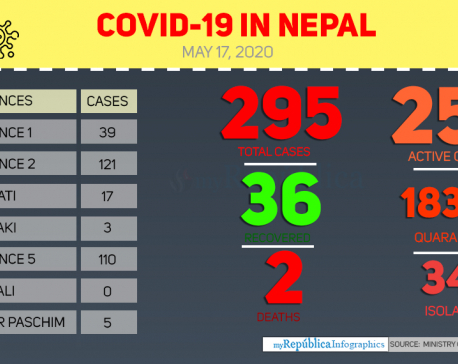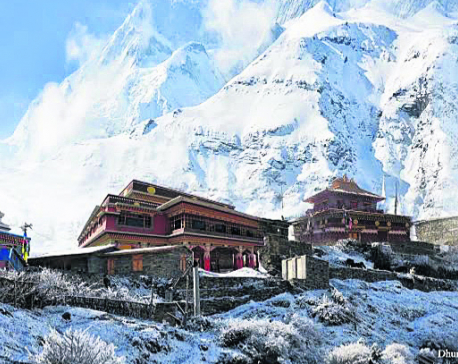
OR
Opinion
Navigating Discrepancies in Development and Prospects
Published On: June 24, 2023 09:00 AM NPT By: Niranjan Mani Dixit

Due to political power in the wrong hands for over three decades, national heroes are desperately recalled for their phenomenal contributions, such as King Prithvi Narayan Shah (1723–1775), founder of Nepal, a sovereign state never been colonized in history and King Mahendra, who divided Nepal into low-cost sustainable Development Regions which transferred power regionally, a decentralized model of state operations.
While on transit in Suvarnabhumi International Airport in Bangkok, I saw a gigantic and magnificent sculpture installed on scene. This depicted the churning of milk ocean (Samundra Manthan), a momentous event enacted by Lord Vishnu (Supreme Personality of the Godhead), as borrowed from the sacred Srimad Bhagavatam scripture in which demigods (devtas) and demons although known to be the fiercest enemies worked together sincerely and diligently to produce nectar. This also served as a guiding principle of the development management framework, needing cooperation and tremendous effort in nation building. I was jealous of the very magnificent sculpture as I wished why Nepal being the only Hindu state until it transitioned into a Federal Republic in 2008, but predominantly still having 81 percent Hindus and 9 percent Buddhists (Buddhism, an extension of Hinduism), did not install it as a resurgence of religiosity and motivation for restoring and revitalizing hard-working culture and national solidarity.
I remember my boyhood days when high-altitude inhabitants of ancient China having an optimistic outlook and hard-working personalities also known to be ‘Bhote’, meaning people of Bhot (Tibet) as adopted by orientalists could be seen visiting Kathmandu for petty seasonal trading activities. In the backstreets they came murmuring and chanting as if they were connected to their Lord even while at work, identical to Karma Yog (of dutiful action), Gyan Yog (of knowledge) and Bhakti Yog (devotional love of God) knotted in the character. Also motivational were the Chinese pictorial magazines available in Bhotahity/Kathmandu in the 1960s which illustrated persistent hard work, innovations and success stories on productive growth in various sectors of development including food security and manufacturing goods. Their persistent and hard-work milieu finally proved foundational for China’s prolific growth in nearly every sector of development, currently becoming the second largest economy in the world after the USA.
Making Nepal Singapore? Making Nepal on a par with Singapore in a decade of time - a giant leap forward - as proclaimed by the Maoist leader and Prime Minister Pushpa Kamal Dahal in 2008 while seeking to already become a ‘great’ man is not yet materialized even by 2023 when he is still a third-time PM.
Contrarily, Nepal became a victim of retrogression in sustained development, rule of law, governance, political stability and territorial integrity. While dreaming of Singapore. After 2008, about 50 semi-government production and employment industries such as agriculture implements, textile, jutes, cigarette, sugar, shoes, paper, cement, rubber and tyre including a dozen of industrial estates were closed down and those never revived nor new ones were established. Aristocratic bossy and glossy ‘tie and suit’ outfit in stiff look not corresponding to national identities and capacity perhaps attributed to the loss of result oriented hard-working-culture of responsibility and accountability.
Ironically, until the early 1940s, Nepal had a high human development index (HDI). This was even better than that of many other countries in Asia and even Switzerland in Europe. A food surplus country until the early 1980s, Nepal was self-reliant and a net exporter. Fast forward to Fiscal Year 2022 Nepal witnessed an international trade deficit of approximately Rs 2,000 billion per annum with import: export ratio of 90:10. Agriculture production dwindled with an annual trade deficit of Rs 400 billion worth food imports. A high import bill in trade with India is also the result of a political predisposition towards India.
The government’s unaccounted expenditure hiked to Rs 900 billion, foreign exchange reserves depleted to pay off import bills for only a quarter and the GDP declined to less than two percent. Nepal's economy plunged into recession and hit the lowest mark for the first time in 60 years, according to WION. Political mafia in nexus with businessmen and civil servants have been ‘milking’ the state as a ‘cow’ resulting in tax evasion and hike in corruption. Not only human capital drained out in an average exodus of 1,800 youths per day, but also illegally earned money siphoned to Swiss Bank and other banks and investments in real estates and companies abroad by the political mafia.
Self-reliance: In a tiny country, Nepal,having eight climate zones from tropical to perpetual snow in an average width of 193 km and given three-fourth area being the hills, and traditionally and genetically being an agrarian economy, appropriate technologies that are viable should be primarily considered over big or mega propositions.
What is preventing us from intensively cultivating every inch of fallow and abandoned land, and maximizing production and productivity for self-sustenance and import substitution? Nepal has no choice but to revolutionize agricultural and industrial productions which are in reverse gear. Agriculture, horticulture, livestock and dairy combined together should receive more attention as 30 million people can derive their three meals a day from this sector.
Due to political power in the wrong hands for over three decades, national heroes are desperately recalled for their phenomenal contributions, such as King Prithvi Narayan Shah (1723–1775), founder of Nepal, a sovereign state never been colonized in history and King Mahendra, who divided Nepal into low-cost sustainable Development Regions which transferred power regionally, a decentralized model of state operations. Each of the Regions had a combination of districts running north to south to inclusively integrate all diversities - geographical, ecological, lingual, ethnic - and to have an equitable share of ample resources for a balanced development.
Future prospects: A high density of 36,000 elected representatives from the federal to local governments, 884 parliamentarians (334 federal lawmakers and 550 provincial lawmakers) and 130 ministers and 136,000 government employees constitute a large workforce. The jumbo government team in the federal setup has become a political recruitment center and the most expensive size to sustain. It has been underutilized needing a slash by at least 50 percent if federalism and socialism are to succeed, and help stop state bankruptcy. Unfortunately, socialism, a socio-economic approach to poverty alleviation and inequality, has been mostly used in Nepal as a gimmick just as federalism to simply fetch votes to attain power.
Outshining nationalists for instance, Mayor Balen Shah, is not only improving the conditions of Kathmandu metropolis, but has also placed a map of ‘Greater Nepal’ in his chamber as a symbolic counter to India’s placing of ‘Akhand Bharat’ mural inclusive of Kapilvastu, Lumbini and Biratnagar of Nepal in its new parliament building in New Delhi. Mayor of Dharan, Harka Raj Rai Sampang, lawmaker Rabi Lamichhane from RSP and Gyanendra Shahi from RPP are other such promising examples. If there are, say 50 such hard working people of clean image, aptitude and nobility in top leadership management roles in the government, Nepal could develop much faster, holistically.
Without wasting any time, energy and resources and playing around lapses, the House of Representative lawmakers and the government including constitutional bodies should be goal-oriented and not too process-oriented in development. Forming myriads of taskforce and commission is not the right approach. To remind, “The more corrupt the state, the more numerous the laws,” said Roman historian Tacitus.
You May Like This

Health ministry confirms three new COVID-19 cases, number of total cases reaches 295
KATHMANDU, May 17: Nepal reported three new cases of COVID-19 on Sunday evening, taking the national tally to 295. ... Read More...

Outreach Nepal lifts Nepal Ice AAN Futsal
KATHMANDU, May 13: Outreach Nepal has lifted the first ever Nepal Ice AAN Futsal Tournament 2018 defeating Media Basket by a... Read More...

Dhurmus, Suntali to build ‘a Nepal within Nepal’
KATHMANDU, June 5: After successfully completing three settlement projects for earthquake victims and other communities, the actor couple Sitaram Kattel (Dhurmus)... Read More...











Just In
- Nepal at high risk of Chandipura virus
- Japanese envoy calls on Minister Bhattarai, discusses further enhancing exchange through education between Japan and Nepal
- Heavy rainfall likely in Bagmati and Sudurpaschim provinces
- Bangladesh protest leaders taken from hospital by police
- Challenges Confronting the New Coalition
- NRB introduces cautiously flexible measures to address ongoing slowdown in various economic sectors
- Forced Covid-19 cremations: is it too late for redemption?
- NRB to provide collateral-free loans to foreign employment seekers








Leave A Comment